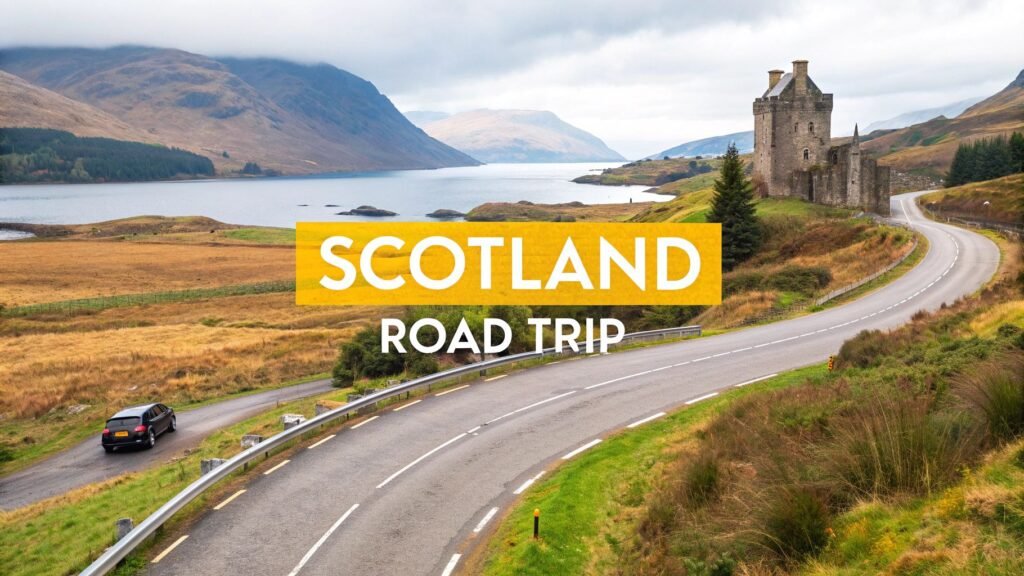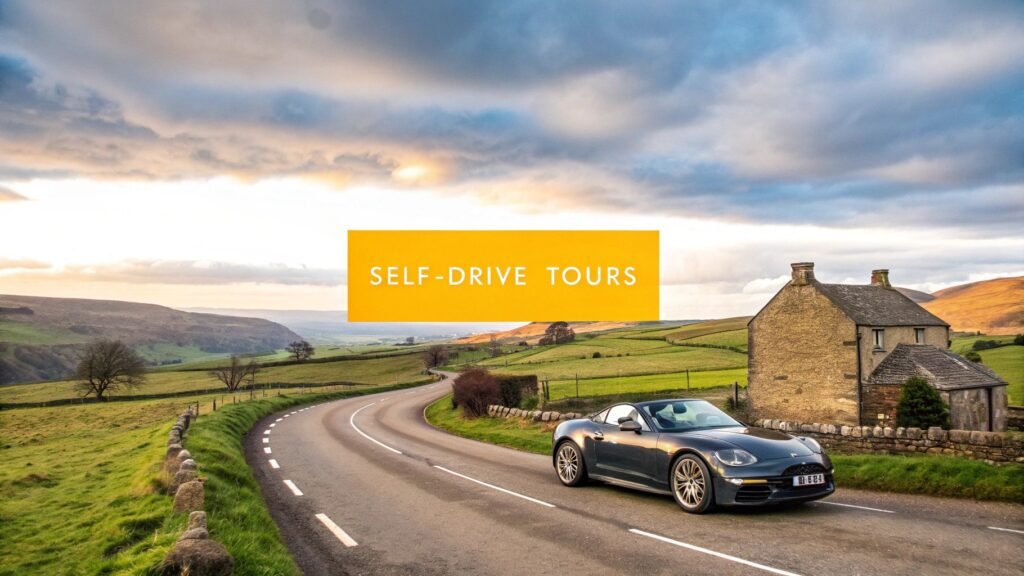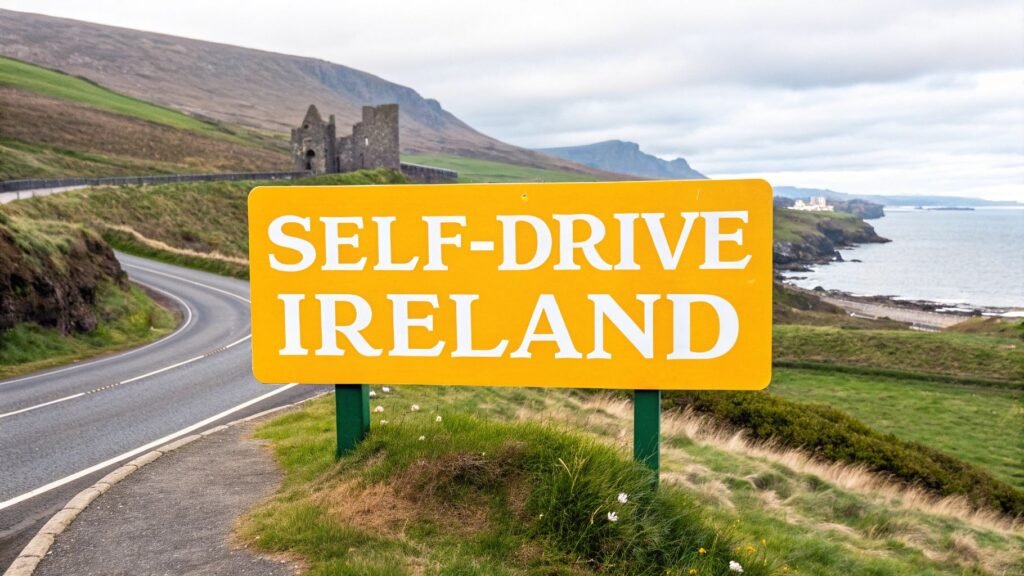Picture this: you’re behind the wheel, a winding road unfolding before you. An ancient castle emerges from the morning mist, and a rugged, dramatic coastline stretches out for miles. This is the very essence of Scotland driving tours. It’s an experience that offers a sense of freedom and personal discovery that you just can’t replicate on a standard tour bus. A self-drive holiday is your ticket to creating a Scottish adventure that is genuinely your own.
Why a Driving Tour Is the Best Way to Experience Scotland
When you think of a trip to Scotland, those dramatic landscapes and historic sites are probably the first things that come to mind. While there are plenty of ways to see the country, a self-drive tour offers a special blend of flexibility and deep immersion that other travel methods can’t quite match. It’s the difference between watching a film about Scotland and actually stepping into the scene yourself.
It all boils down to one simple thing: freedom.
With your own car, you’re not a slave to strict timetables or fixed routes. You have the power to chase the perfect light for a photograph, linger over a fantastic pub lunch in a village you’ve fallen in love with, or take a spontaneous detour down a narrow lane that looks like it leads somewhere magical.
This independence is precisely how you find the real Scotland—the one that exists between the famous landmarks. It’s in those unplanned stops that the most precious memories are often made.
- Uncover hidden gems: You can pull over anytime to explore a secluded beach or a quiet loch that isn’t even in the guidebooks.
- Travel at your own rhythm: Spend hours exploring a castle that completely captivates you, or simply pass through a town that doesn’t quite pique your interest.
- Reach remote beauty: A car is your key to unlocking distant glens, trailheads, and coastal corners that are incredibly difficult, if not impossible, to get to using public transport.
The Numbers Speak for Themselves
It’s clear this way of travelling is a favourite. Data from VisitScotland’s 2023 Visitor Survey shows that driving is the top choice for visitors coming from the rest of the UK. A massive 61% of these visitors travel to Scotland by car, a figure that dwarfs train travel (14%) and flying (10%). This really highlights the appeal of having your own wheels to explore the country’s incredible sights.
The real magic of a road trip isn’t just getting from A to B; it’s the personal story you create along the way. Your journey becomes a collection of spontaneous decisions, unexpected sights, and personal discoveries.
While we’re talking about roads, the appeal of unforgettable scenic rides by rail shares a similar spirit, where the journey itself is the main event. This resonates with why so many people choose to explore Scotland by car. It’s about more than just transport; it’s about experiencing the landscape in an active, personal, and profoundly memorable way. A driving tour turns you from a spectator into a true explorer, with you firmly in charge of your own Scottish saga.
To give you a head start, here’s a quick look at some of the most popular driving adventures Scotland has to offer. This should help you decide which one is the right fit for your trip.
Quick Guide to Popular Scotland Driving Routes
| Route Name | Region | Typical Duration | Highlights |
|---|---|---|---|
| North Coast 500 | North Highlands | 5-7 Days | Dramatic coastal scenery, fairy-tale castles, remote beaches. |
| Argyll Coastal Route | West Coast & Islands | 3-5 Days | Stunning lochs, historic castles, access to islands like Islay and Mull. |
| Heart 200 | Central Scotland | 3-4 Days | Loch Lomond & The Trossachs, Perthshire forests, historic city of Stirling. |
| South West Coastal 300 | Dumfries & Galloway | 3-4 Days | Unspoilt coastlines, dark sky parks, connection to Robert Burns. |
Each of these routes offers a unique flavour of Scotland, from the wild, untamed north to the gentle, rolling hills of the south. Whichever you choose, you’re guaranteed an unforgettable journey.
Choosing Your Perfect Scottish Road Trip Itinerary
Picking the right route for your Scottish road trip is a bit like choosing the perfect soundtrack for a film; each one sets a completely different mood and creates its own unique atmosphere. Scotland is packed with an incredible variety of driving tours, so you’re guaranteed to find one that feels just right, whether you’re chasing dramatic coastal views or want to lose yourself in ancient history.
Let’s dive into some of the most iconic circuits and what makes each one so special. This should help you pinpoint the driving tour that matches your holiday dreams, whether you’ve got a long weekend or a full two weeks to play with.
The scenery waiting for you on Scotland’s famous routes is nothing short of breathtaking, as you can see.
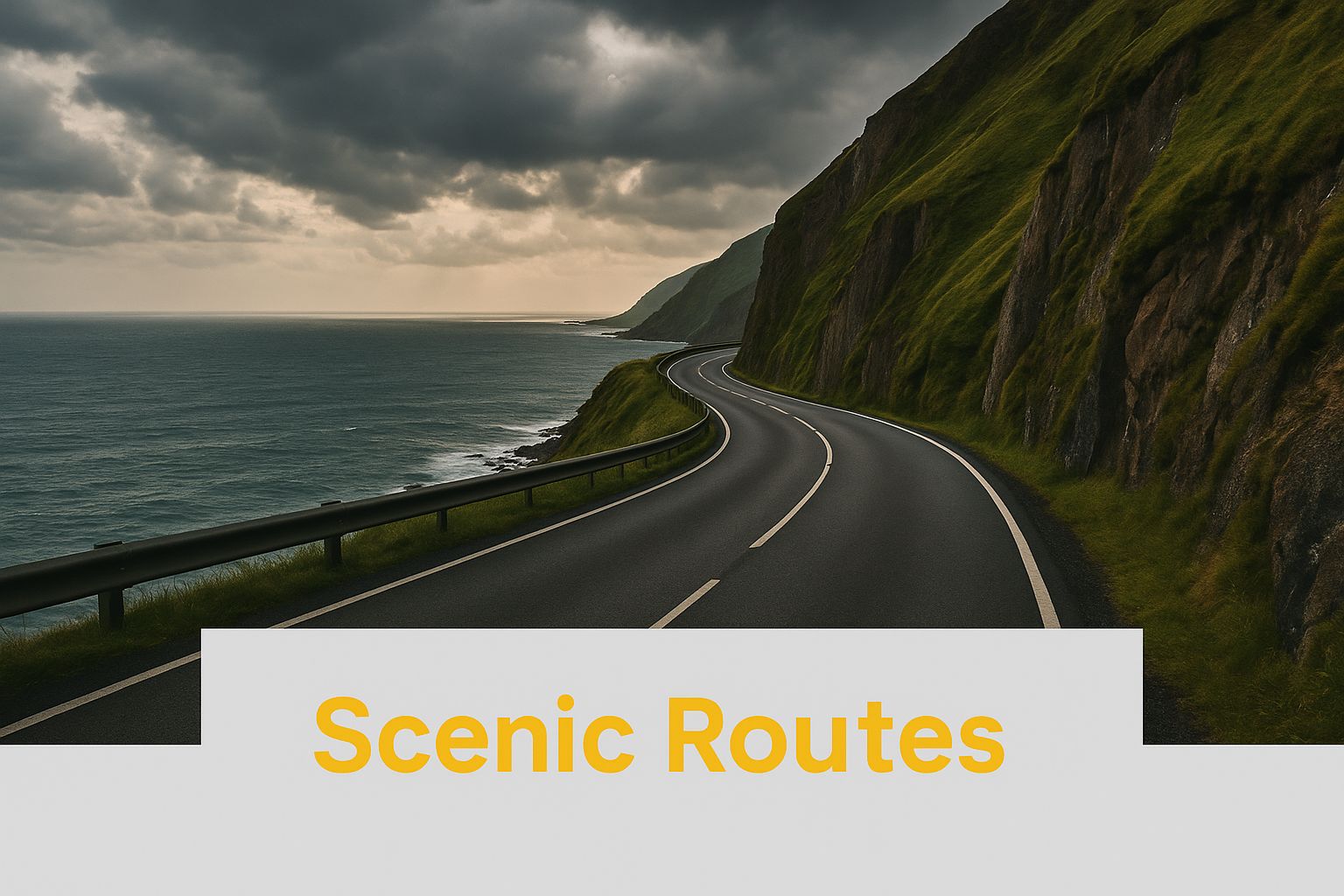
This picture perfectly captures that mix of wild coastline and wide-open road that makes a self-drive trip here so unforgettable.
The Legendary North Coast 500
Often called Scotland’s own Route 66, the North Coast 500 (or NC500) is easily the country’s most famous road trip, and for very good reason. This epic 516-mile loop kicks off at Inverness Castle, tracing the rugged northern coastline in one spectacular circuit before bringing you right back where you started.
This is a journey for anyone who loves raw, untamed landscapes. You’ll be navigating winding single-track roads that cling to cliffsides, discovering pristine white-sand beaches that could be mistaken for the Caribbean (if you ignore the water temperature!), and passing through some of Europe’s most ancient and dramatic scenery.
Key Highlights on the NC500:
- Bealach na Bà: A legendary, heart-in-your-mouth single-track pass with hairpin bends and views that will leave you speechless.
- Smoo Cave: A massive sea and freshwater cave that you can actually explore by boat. It’s a truly dramatic spot.
- John o’ Groats: The famous, most northerly point on the British mainland – a classic photo opportunity.
- Dunrobin Castle: A stunning, fairy-tale castle that looks like it’s been plucked straight out of a storybook.
To really do the NC500 justice, you need to set aside at least 5-7 days. Rushing it means you’ll miss its soul. The best times to go are late spring (May-June) or early autumn (September) to dodge the peak summer crowds and the infamous Scottish midges.
The Castle-Rich North East 250
If your idea of Scotland involves more turrets and towers than windswept cliffs, then the North East 250 is your perfect match. This beautiful circular route winds through Aberdeenshire, Speyside, and the Cairngorms National Park, a region boasting over 260 castles, stately homes, and atmospheric ruins.
This journey is a deep dive into Scottish history, from ancient clan strongholds to royal residences. It’s also the heart of Scotland’s whisky country, with dozens of world-class distilleries dotted along the route, just waiting for you to stop in for a dram.
The scenery shifts beautifully from the dramatic mountain passes of the Cairngorms to the gentle coastline of the Moray Firth, where you might even spot dolphins. It offers a more varied landscape than the NC500, blending mountain grandeur with coastal charm. For those who want to blend history with local flavours, our Taste of Scotland 8-Days Self-Drive Tour has it all planned out for you.
The Central Heart 200
Got less time on your hands or just want a taste of everything Scotland offers? The Heart 200 is a fantastic option. This 200-mile loop is right in the centre of the country, making it incredibly easy to get to from Glasgow and Edinburgh. It cleverly connects Loch Lomond & The Trossachs National Park with the historic cities of Stirling and Perth.
Think of the Heart 200 as a “greatest hits” album of Scotland. In just a few days, you can experience:
- Stunning Lochs: Take a cruise on the iconic Loch Lomond or the beautifully serene Loch Tay.
- Majestic Forests: Explore the enchanting woodlands of Perthshire, famously known as ‘Big Tree Country’.
- Pivotal History: Stand on the battlements of Stirling Castle, where Scottish kings and queens were once crowned.
This route is absolutely perfect for a 3-4 day trip and is manageable all year round, though the autumn colours in Perthshire are something truly special.
The Undiscovered South West Coastal 300
While the Highlands tend to steal the spotlight, the South West Coastal 300 (SWC300) is a real hidden gem just waiting to be explored. This route loops around the captivating coastline and rolling green hills of Dumfries and Galloway.
It’s a journey of quiet beauty and artistic inspiration. The region is famously linked with Scotland’s national poet, Robert Burns, and you can visit his birthplace and museum. The route also takes in unspoilt beaches, lush forests, and the UK’s first Dark Sky Park in Galloway Forest Park, where the stargazing is simply phenomenal.
The SWC300 offers a much more tranquil driving experience. With fewer crowds and a gentler pace, it’s ideal for travellers seeking a peaceful escape filled with nature, poetry, and starry, starry nights. A 3-4 day trip is usually plenty of time to soak up its unique charm.
Mastering the Art of Driving in Scotland
Getting behind the wheel in Scotland is where the real adventure begins. But let’s be honest, for a lot of visitors, the idea of driving on the left or navigating those famous single-track roads can cause a bit of a flutter.
Don’t worry. With the right approach and a few local insights, that initial nervousness will quickly melt away, leaving you free to explore with confidence.
First up: driving on the left. If you’re used to driving on the right, it’s going to feel a bit strange for the first hour or two. The simplest trick is to remember that as the driver, you should always be positioned towards the centre of the road. On roundabouts, which you’ll see everywhere, just give way to any traffic coming from your right and go around clockwise.
Honestly, you’ll be surprised how quickly you adapt. Most people find it feels completely natural after a day or so. A great tip is to hire an automatic car. It means you won’t have to worry about shifting gears with your left hand, which lets you focus all your attention on your road position.
Understanding Single-Track Roads
The true soul of a rural Scottish road trip is found on the single-track roads. These narrow, winding routes aren’t just for getting from point A to B; they are the experience, taking you through some of the country’s most breathtaking landscapes. Think of it less as a driving challenge and more like a beautifully coordinated dance.
The whole system hangs on passing places. These are little pull-outs or wider bits of road specifically designed to let two cars get past each other. The etiquette is simple but absolutely vital for keeping everything moving.
- If the passing place is on your left: Pull in and wait for the oncoming car to pass.
- If the passing place is on your right: Stop on your side of the road, right opposite the passing place. This gives the other driver enough room to manoeuvre around you.
- Look ahead: Always keep your eyes scanning down the road. If you spot an oncoming car and a passing place is closer to them, it’s often best to find a spot to wait before you even meet.
The golden rule of single-track roads is to never, ever park in a passing place. They aren’t for stopping to take photos or have a stretch. Using them as a car park can cause huge tailbacks and is a real source of frustration for locals.
And don’t forget the wave! A simple, friendly wave to thank a driver who has pulled over for you is a small gesture that means a lot. It’s a cherished part of the driving culture in the Highlands and shows you’re a considerate traveller.
Practical Tips for Your Journey
Beyond the rules of the road, a few practical pointers will make your self-drive tour that much safer and more enjoyable. Scotland’s conditions can be all over the place, but being ready for them is half the battle.
Fuel and Supplies
Out in remote spots like the Highlands and Islands, petrol stations can be few and far between. They also tend to close much earlier than you might be used to. A good rule of thumb is to never let your tank get below half-full. If you see a petrol station, it’s almost always a smart move to top up.
Weather and Wildlife
The Scottish weather is famously fickle. You could start the day with brilliant sunshine and be driving through thick mist or a torrential downpour an hour later. Always drive at a speed that feels safe for the conditions, and be ready for poor visibility, especially on high mountain passes.
Finally, prepare yourself for the occasional ‘woolly roadblock’. Sheep on unfenced roads are a common sight, and they couldn’t care less about your travel schedule. Just slow down, be patient, and soak up the moment—it’s all part of the authentic charm.
For those who want to take all the guesswork out of their trip, exploring fully planned self-drive tours is a fantastic option, ensuring all the logistical details are sorted for you.
Planning Your Accommodation and Daily Stops
A brilliant Scotland road trip is about so much more than just the drive. It’s a collection of moments, and that absolutely includes the memorable places you rest your head each night. While the scenery is the star of the show, how you plan your daily stops and overnights can make the difference between a frantic dash and a truly immersive adventure.
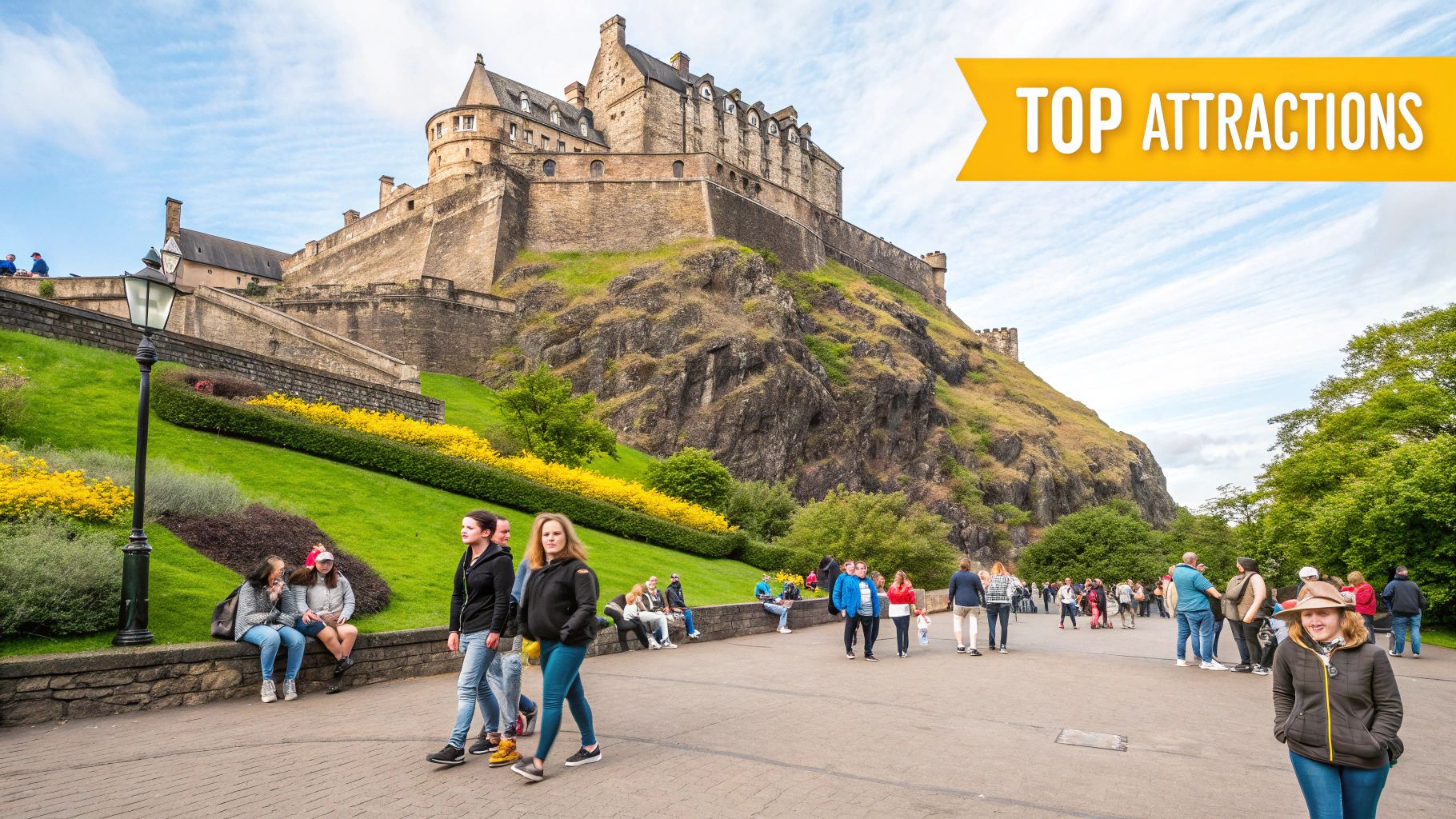
The trick is to find a sweet spot between your driving ambitions and a realistic daily pace. Simply racing from one landmark to the next is a surefire way to burn out and miss the spontaneous magic that makes these journeys so special. A well-thought-out itinerary leaves breathing room for those unexpected photo stops, leisurely pub lunches, and impulsive detours down intriguing single-track roads.
Choosing Where to Stay
Scotland offers an incredible variety of accommodation that can easily become a highlight of your trip. Forget generic chain hotels; this is your chance to stay somewhere with genuine character and charm. Each option gives you a different taste of Scottish hospitality.
- Historic Castle Hotels: For the ultimate romantic or bucket-list experience, staying in a castle is something you’ll never forget. These places brilliantly blend centuries of history with modern comfort and luxury.
- Cosy Bed & Breakfasts (B&Bs): This is hands-down the best way to get a feel for local life. The hosts are often walking encyclopaedias of insider tips, and you simply can’t beat a proper, home-cooked Scottish breakfast to start your day.
- Self-Catering Cottages: Perfect for families or anyone wanting a bit more freedom, a cottage gives you a home away from home. Having your own kitchen means you can sample local produce and cook for yourselves.
- Modern Glamping Pods: For something a bit different and often more eco-friendly, glamping pods offer comfort and style right in the heart of nature, frequently with breathtaking loch or mountain views.
Booking your accommodation well in advance is essential, especially if you’re travelling during the peak summer months (June-August) or tackling a popular route like the North Coast 500. For key destinations, it’s non-negotiable. Take Edinburgh, Scotland’s bustling capital, which welcomed 5.34 million visitors in 2023. With the average visitor staying in Scotland for 8.7 nights—many of which are based in hubs like this—the demand for the best spots is fierce. To avoid being disappointed, booking several months ahead is a very smart move. You can dig into what these trends mean for your trip by exploring more of Scotland’s tourism statistics.
Pacing Your Daily Drives
A classic mistake people make on a driving tour is trying to cram too much into a single day. On a map, 150 miles might not look like much, but on Scotland’s winding, often single-track roads, that can easily turn into four or five hours of solid driving, and that’s before you stop for anything.
A good rule of thumb for a relaxing pace is to aim for 100-120 miles (160-190 km) of driving per day. This leaves plenty of time to explore a castle, head out for a short hike, or simply find a quiet spot by a loch and soak it all in.
Think of your itinerary as a flexible guide, not a strict rulebook. The real joy of a self-drive tour is the freedom it gives you. If you fall in love with a particular village and want to linger, give yourself permission to do so, even if it means tweaking the next day’s plan.
Wild Camping in a Campervan
For those exploring in a campervan or motorhome, Scotland offers the incredible freedom of ‘wild camping’, thanks to the Scottish Outdoor Access Code. This allows you to park overnight in many unenclosed areas, but it’s a privilege that comes with important responsibilities.
The Essentials of Wild Camping Etiquette:
- Be Considerate: Park well away from people’s homes and never block gates or access routes. It’s crucial you don’t park in designated passing places on single-track roads.
- Leave No Trace: This is the golden rule. Take all your rubbish with you and leave the area exactly as you found it—or even better.
- Stay for a Short Time: The spirit of wild camping is about moving on. Plan to stay for one or two nights at most before finding your next spot.
- Use Facilities Responsibly: Only dispose of chemical toilet waste at designated disposal points, which you can find at most official campsites.
By carefully planning your daily distances and booking your unique stays ahead of time, you set yourself up for a seamless and deeply rewarding journey. It’s this thoughtful approach that will ensure your Scotland driving tour is both thrilling and perfectly paced.
Discovering Unforgettable Experiences Beyond the Drive
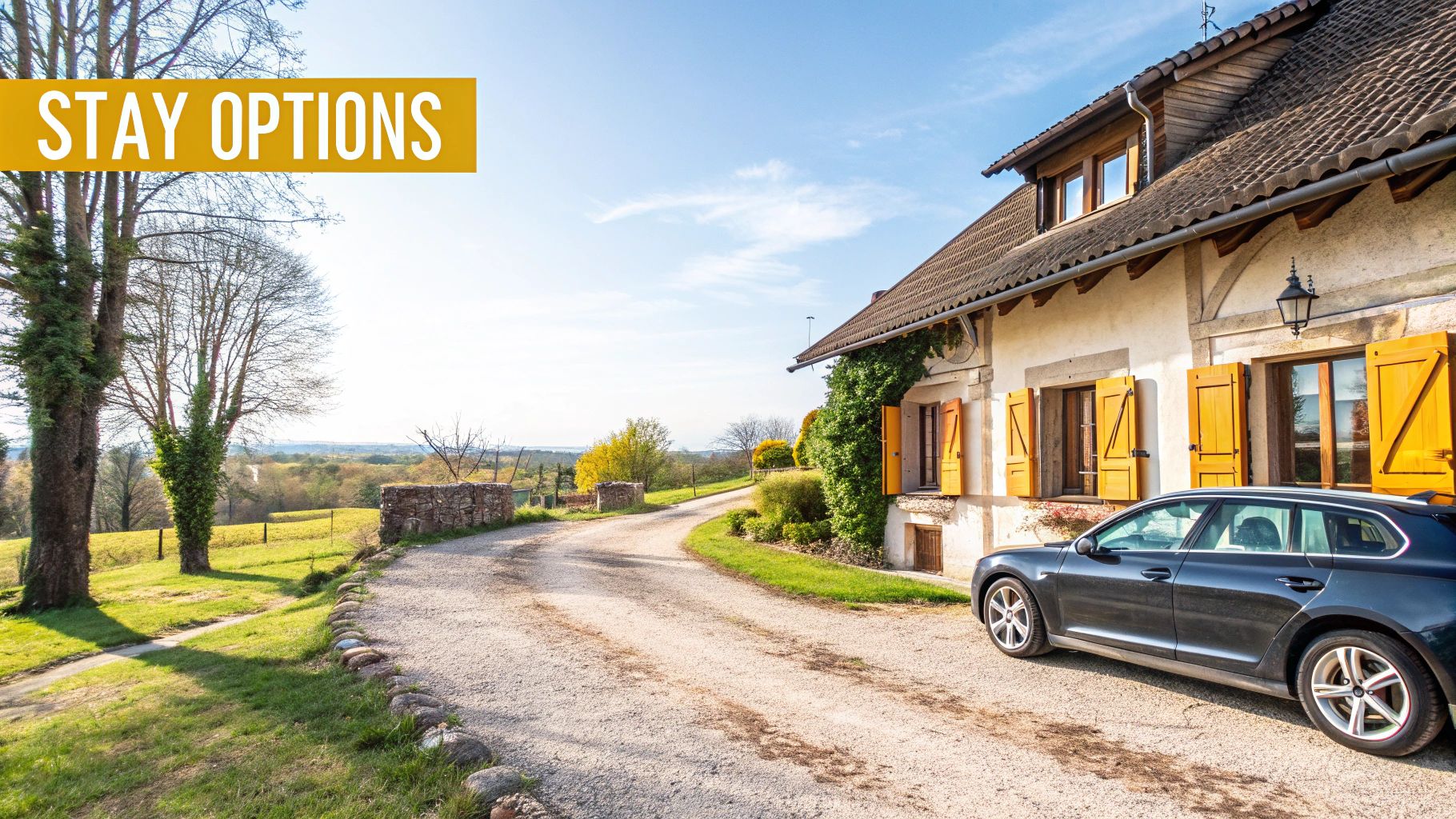
While the winding roads and epic scenery are the backbone of any Scottish road trip, the country’s true soul reveals itself the moment you turn off the engine. The drive gets you to the doorstep of adventure, sure, but the most powerful memories are made when you step out and immerse yourself in the activities that define this incredible land.
A truly great driving tour isn’t just a list of places to see; it’s a collection of moments to be lived. It’s about weaving these experiences into the fabric of your itinerary to connect with the history, culture, and nature that make Scotland so completely enchanting.
Stepping into History and Myth
Scotland’s landscape is essentially a living museum, dotted with ancient castles, mysterious standing stones, and battlefields where the nation’s destiny was forged. These aren’t just photo opportunities; they are portals to the past.
A visit to a castle like the iconic Eilean Donan, perched majestically on its own island, is an absolute must. It’s more than just a beautiful fortress; its restored interior gives you a real, tangible sense of what clan life was actually like. Likewise, a journey to the Callanish Standing Stones on the Isle of Lewis or the Ring of Brodgar in Orkney is a profound experience. Walking among these neolithic monuments, you can’t help but feel a powerful connection to the ancient people who built them thousands of years ago.
The enduring appeal of Scotland’s rich history and dramatic landscapes continues to captivate travellers. The post-pandemic resurgence in travel, coupled with a lasting enthusiasm for road trips and the cultural impact of series like ‘Outlander’, ensures that driving tours through these storied regions remain exceptionally popular. You can explore more about what makes these journeys so compelling by checking out the travel discussions on Rick Steves’ Europe.
Savouring the Flavours of Scotland
Your culinary journey is every bit as important as your road journey. Scotland’s food and drink scene is a huge part of its culture, offering warmth, comfort, and a true taste of the place after a day of exploration.
A Toast to Whisky: No trip to Scotland would be complete without visiting at least one distillery. From the peaty, smoky whiskies of Islay to the smooth, honeyed drams of Speyside, a tour offers a fascinating look into centuries of craft. You’ll learn about the angels’ share, the crucial role of the local water source, and, of course, enjoy a tasting. It’s a delightful way to spend an afternoon.
Pubs and Local Produce: For a truly authentic meal, seek out a traditional pub. This is where you’ll find classic dishes like Cullen skink (a creamy smoked haddock soup), haggis with neeps and tatties, or incredibly fresh, locally caught salmon. Many pubs pride themselves on sourcing ingredients from nearby farms and waters. If you fancy building a trip around these delicious experiences, our dedicated Scotland Culinary 8-Days Self-Drive Tour is the perfect starting point.
Embracing the Great Outdoors
That rugged beauty you see from your car window is an open invitation to get out and explore on foot. Even short walks can lead to incredible rewards, offering perspectives you’d otherwise miss entirely.
- Wildlife Spotting: Keep your eyes peeled and your binoculars handy. You might just spot majestic red deer in the glens of the Cairngorms, playful otters hunting along the coast, or comical puffins nesting on sea cliffs during the summer months.
- Accessible Hikes: You don’t need to be a seasoned mountaineer to enjoy a Scottish hike. Many popular spots, like the walk to the stunning Fairy Pools on Skye or a gentle stroll around a quiet loch, offer spectacular views for surprisingly little effort.
These are the kinds of activities that transform your Scotland driving tour from a simple road trip into a deep, multi-sensory adventure. By balancing your time behind the wheel with time spent exploring on your own two feet, you’ll create a much richer and more personal journey.
Your Questions About Scotland Driving Tours Answered
Planning your first road trip around Scotland can feel like plotting a grand expedition. It’s a thrilling prospect, but I know from experience that it also brings up a fair few questions. To help you iron out those final details and hit the road with confidence, I’ve put together some straightforward answers to the most common queries I hear.
Think of this as your final pre-flight check, making sure you’re ready for everything from fickle weather to those famously winding single-track lanes.
What Is the Best Time of Year for a Driving Tour in Scotland?
Choosing the right season for your Scotland driving tour will massively shape your whole experience. While you can have a great time year-round, most seasoned travellers point to the shoulder seasons as the real sweet spot.
Spring (April-May) and autumn (September-October) offer a fantastic balance. You’ll generally find decent weather, far fewer crowds clogging up the popular routes, and better prices on accommodation and car hire. The scenery is also at its most dramatic; spring sees the hills burst into life with wildflowers, while autumn sets the forests of Perthshire ablaze in fiery reds and golds. Critically, you’ll also miss the worst of the dreaded midges (tiny biting insects) that can be a real nuisance in the summer.
Summer (June-August) has one huge advantage: daylight. With light sometimes lasting until 10 p.m. in the far north, you get so much more time for exploring each day. The trade-off is that this is peak season. Expect bigger crowds at hotspots like the Isle of Skye and along the North Coast 500, plus higher prices for just about everything.
Winter (November-March) can be utterly magical, with snow-dusted mountains and a real sense of tranquillity. It’s not without its challenges, though. Daylight hours are very short, and some rural roads—especially high passes—can be closed due to snow or ice, which could throw a spanner in your itinerary.
Do I Need a 4×4 Vehicle to Drive in Scotland?
This is a question I get all the time, and the answer is almost always a simple no. For the vast majority of Scotland driving tours, including the famous North Coast 500 and scenic routes through the Highlands, a standard 2-wheel drive car is all you need.
Every public road, even the narrowest single-track lane, is paved and maintained. You’d only need a 4×4 if you were planning to head far off the beaten path onto private, unpaved estate tracks—something most visitors won’t ever need to do.
In fact, a smaller car is often a huge plus. Navigating narrow village streets, tight bends, and especially the single-track roads with their passing places is far easier and less stressful in a more compact vehicle. When you’re booking your rental, think small and nimble.
How Much Should I Budget for a One-Week Driving Tour?
Your budget will obviously hinge on your travel style, but it helps to have a rough ballpark figure. For a comfortable, mid-range one-week (7-day) driving tour in Scotland, a good estimate is somewhere between £900 and £1,400 per person.
To give you a better idea, here’s how that might break down per day:
- Accommodation: £60 – £120 per night for a nice B&B or a mid-range hotel.
- Car Rental: £30 – £50 per day for a small, automatic car (including basic insurance).
- Fuel: £20 – £30 per day, depending on how much ground you cover.
- Food: £40 – £60 per day for a mix of pub dinners, cafe lunches, and snacks.
- Attractions: £20 – £40 per day for things like castle tickets and distillery tours.
Of course, you can absolutely do it for less by staying in hostels, choosing self-catering, and focusing on free activities like hiking. On the flip side, if you fancy luxury hotels and fine dining, your costs will climb. The best way to keep your budget in check is to book your car and accommodation well in advance to lock in the best rates.
What Is the Most Important Rule for Single-Track Roads?
Getting the hang of single-track roads is the key to unlocking Scotland’s most remote and beautiful corners. It might look intimidating at first, but the system is incredibly simple and all comes down to one golden rule: always be ready to stop at a passing place.
These are the clearly marked wider sections of the road. The etiquette is second nature to locals and vital for keeping things moving.
- If the passing place is on your left, pull into it and wait for the oncoming car to pass you.
- If the passing place is on your right, stop on the main road opposite the passing place. This allows the other driver to pull into it and drive around you.
- Look ahead and be proactive. Scan the road ahead. If you see an oncoming car and a passing place is closer to you, it’s good form to pull in and wait, even if they’re still a fair way off.
And one last thing: a simple, friendly wave to a driver who pulls over for you is a deeply ingrained part of Highland driving culture. It’s a small gesture of thanks that makes the whole experience better for everyone.
Ready to stop questioning and start exploring? At BTOURS, we take all the guesswork out of planning. Our expertly curated self-drive itineraries in Scotland handle all the details, from the perfect route to charming accommodations, leaving you free to simply enjoy the drive of a lifetime. Discover your perfect Scottish adventure with us.

